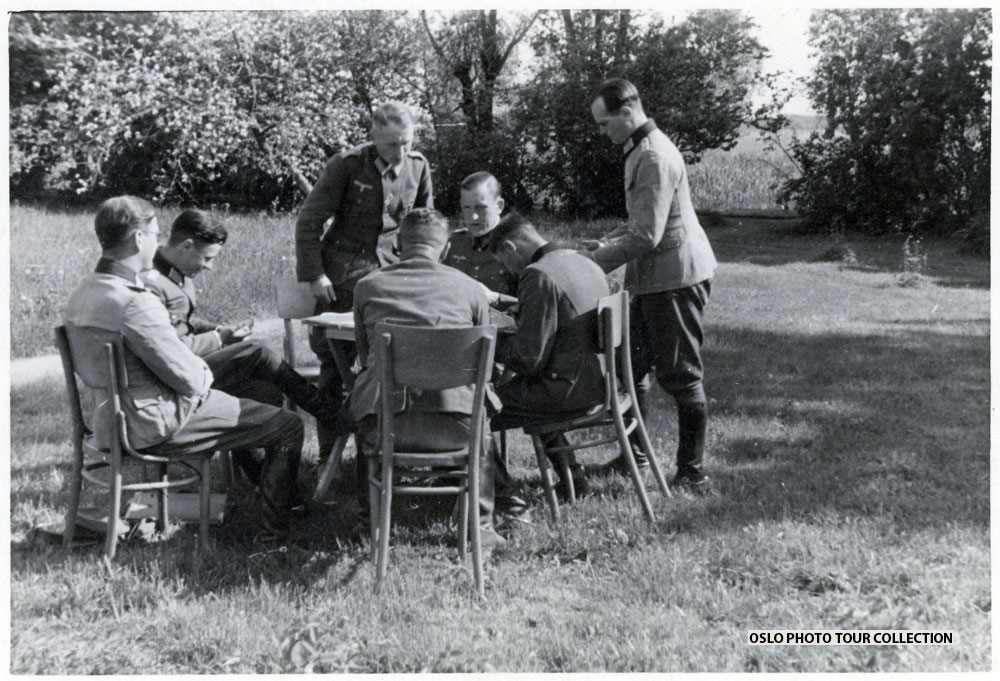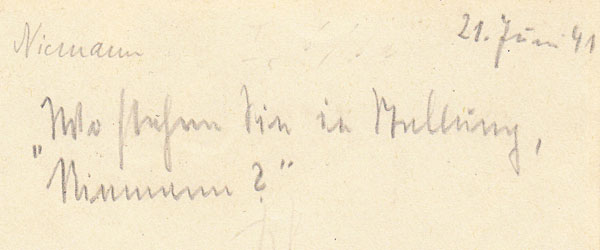

21 июня 1941. Где наша позиция Ниман? June 21, 1941. Where is your position, Niemann?
фотограф: Сержант-майор армии Franz Richarz.
С января по август 1937 года во 2-й роте инженерного батальона 26 в Кёльн-Вестховене. С сентября 1937 года в составе 1-й роты 2-го инженерного батальона (Pionier-Lehr-Bataillon 2) в Фюрстенвальде. Вторжение в Австрию в марте 1938 года, в октябре 1938 года в Судетскую область, Демобилизован в качестве сержанта в Фюрстенвальде в конце октября 1938 года. Мобилизация в августе 1939 года в составе 6-й роты 68-го железнодорожного инженерного полка, С этим подразделением он затем был направлен в Польшу и на Западный вал.
В апреле 1940 года его подразделение было переименовано в 6-й железнодорожный инженерный полк 3. Затем он воевал в Бельгии, Франции и на южном участке Восточного фронта до 1944 года. Ранен в Крыму (16.02.1944), пережил войну.
photographer: Sergeant Major of the Army Franz Richarz.
January to August 1937 with the 2nd Company of the Engineer Battalion 26 in Cologne-Westhoven. From September 1937 with the 1st Company of the Engineer-Lehr-Bataillon 2 in Fürstenwalde. March 1938 invasion of Austria, October 1938 in the Sudetenland, End of October 1938 discharged as NCO in Fürstenwalde. August 1939 mobilization with d. 6. company of the Eisenbahn-Pionier-Regiment 68, with this unit he was then deployed in Poland and at the Westwall. April 1940 renamed his unit to 6th / Railway Engineer Regiment 3. He then fought in Belgium, France and on the southern section of the Eastern Front until 1944. Wounded in the gang fight in the Crimea (16.02.1944), he survived the war.
original text: Oberfeldwebel des Heeres Franz Richarz.
Januar bis August 1937 bei d. 2. Kompanie des Pionier-Bataillon 26 in Köln-Westhoven. Ab September 1937 bei d. 1. Kompanie des Pionier-Lehr-Bataillon 2 in Fürstenwalde. März 1938 Einmarsch in Österreich, Oktober 1938 im Sudetenland, Ende Oktober 1938 als Unteroffizier in Fürstenwalde entlassen. August 1939 Mobilmachung bei d. 6. Kompanie des Eisenbahn-Pionier-Regiment 68, mit dieser Einheit wurde er dann in Polen und am Westwall eingesetzt. April 1940 Umbenannung seiner Einheit in 6./ Eisenbahn-Pionier-Regiment 3. Er kämpfte dann in Belgien, Frankreich und am Südabschnitt der Ostfront bis 1944. Verwundet im Bandenkampf auf d. Krim (16.02.1944), hat er den Krieg überlebt.